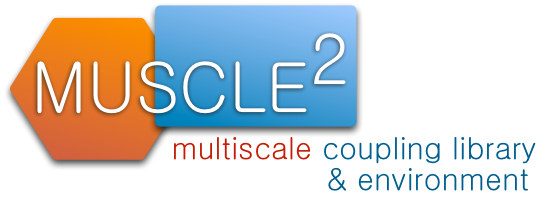| Version 27 (modified by jorisborgdorff, 12 years ago) (diff) |
|---|
MUSCLE 2 Installation
The recent bundle of MUSCLE can be downloaded from the Downloads section. The bundled package contains the source code, documentation and precompiled Java archives (jar). We maintain a list of clusters where MUSCLE is already deployed.
The offered version of MUSCLE 2 in extends and improves the package provided by Jan Hegewald. We can list here the following elements:
- improved installation procedure (some dependencies are already included in the bundle),
- added support for generation of OTF trace logs,
- updated API
- implemented Port Range traversing technique for cross-cluster execution.
Dependencies
The core functionality of the MUSCLE is written in Java. To be able to integrate native code with the MUSCLE, there is also a native part which is written in C++. Bootstrapping and platform independent configuration is done with a flexible setup mechanism written in Ruby.
In order to use the MUSCLE, you need a recent Java runtime, either Oracle-Java or Open-JDK. Java third-party dependencies are already provided in the bundle and do not need to be independently installed.
For the command-line interface Ruby is needed.
To compile and install MUSCLE, use the CMake package. For the MUSCLE Transport Overlay, to communicate between different clusters, Boost is needed.
Installation of dependencies on a Debian flavored Linux
Run
sudo apt-get install build-essential cmake ruby libboost-dev
to install all dependencies at once.
Installation of dependencies on Scientific Linux 5.6
Note: Some part of the presented installation procedure requires to be invoked by root.
yum install ruby gcc-c++ cmake jdk curl
Note: you may need to add the reference to the repository with extra packages. To do this create the file 'epel.repo' in the /etc/yum.repos.d directory. The content of the file may look as follows:
[epel] name=Extra Packages for Enterprise Linux 5 - $basearch #baseurl=http://download.fedoraproject.org/pub/epel/5/$basearch mirrorlist=http://mirrors.fedoraproject.org/mirrorlist?repo=epel-5&arch=$basearch failovermethod=priority enabled=1 gpgcheck=0
Installation of dependencies on Mac OS X
Most dependencies are installed when installing Xcode. In Xcode 4.4, the command-line tools are installed by opening Preferences -> Downloads and pressing Install at the item "Command-line tools". For Boost and CMake, download the packages on their website or use an installation manager like HomeBrew or MacPorts.
Remainder of the installation
If your ruby version is 1.8.x:
ruby --version
then it is necessary to install json with the following command
sudo gem install json
When the dependencies are in place, you are ready to build and install MUSCLE. Download the muscle bundle from Downloads section, e.g.
curl -#O http://apps.man.poznan.pl/trac/muscle/downloads/muscle-2.0-RC1.zip
Extract the download, e.g.
$ unzip muscle-2.0-RC1.zip
Change your working directory to the the MUSCLE directory:
$ cd muscle-2.0-RC1/build
Invoke MUSCLE build script with installation; this installs MUSCLE in /opt/muscle. For another location, add this as the first argument.
sudo ./build.sh
See if MUSCLE is working correctly:
source /opt/muscle/etc/muscle.profile muscle2 --version
The command
source /opt/muscle/etc/muscle.profile
should always be run before executing MUSCLE. It can help to put this command in ~/.bashrc so that it runs at login.
Further reading
For more information how to use MUSCLE see the Documentation and Tutorials sections.
For MUSCLE version 1.x installation, see MUSCLE1 Installation
